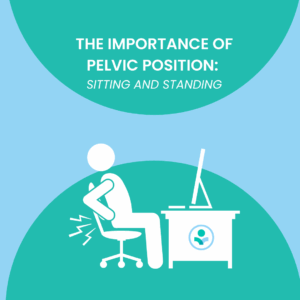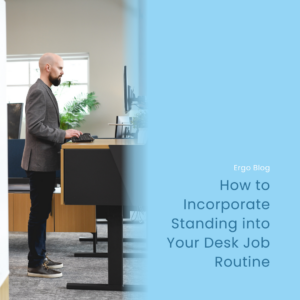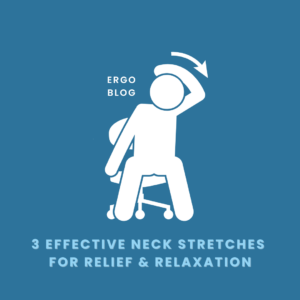Updated: Mar 16, 2023
Sciatica and Ergonomics
Sciatica refers to the pain that travels along the path of the sciatic nerve. The pain that is associated with sciatica can affect the lower back, through the hips and buttocks, and down each leg. Most of the time, sciatica occurs when the sciatic nerve becomes pinched. This can happen when a herniated disk or an overgrowth of a bone puts pressure on part of the sciatic nerve. Sciatica usually affects only one side of the body. Other symptoms can include numbness, tingling, or even muscle weakness in the affected leg of the foot.
When people are experiencing sciatica, early treatment is necessary to hopefully prevent symptoms from becoming severe. If you have questions about symptoms you may be feeling, contact your primary care provider.
Risk factors for sciatica include age, obesity, diabetes, and other ergonomic concerns such as prolonged sitting, twisting the back, carrying heavy loads, or driving a motor vehicle for long periods.
3 Tips to Prevent Sciatica
Preventing sciatica is not always possible and some people experience the condition more than once in their lives. However, these tips can greatly decrease the likelihood of sciatica being a concern in your life.
1. Exercise. Maintain a healthy lifestyle by exercising regularly. Based on cdc.gov, adults need 150 minutes of moderate-intensity physical activity and 2 days of muscle strengthening activity. Moderate-intensity physical activity can be split up throughout the week, such as 30 minutes, 5 days a week. There is no specific time for muscle strengthening. Exercises that focus on core strengthening of the lower back and abdomen can have the greatest impact on preventing sciatica.
2. Good posture. Practicing good posture is something to be mindful of in all aspects of life and even more so when preventing sciatica. If you are wanting to improve your posture, make sure your environment, such as your chair, is set up in your favor. Choose a chair with good lower back support and adjustable armrests. Also, set the height of your chair so your thighs are parallel to the floor. Your hips, knees, and elbows should be at 90-100 degrees of flexion. Using your chair to support you will allow your upper body weight to be dispersed throughout other areas of your body and not just through your back and hips. Refer to How to Set Up an Office Chair for more chair positioning information.
If you do not feel that you have enough lower back or lumbar support with your current chair, you can roll a towel and place it in between your chair and your lumbar spine. Avoid using a cushion or pillow that is too large as this could place you in a position where you are pushed too far forward in your chair and you end up losing your upper back support and seat pain support. When you do not have the proper support around you, good posture can be quite difficult to maintain. This is because your muscles may fatigue which results in a slouched or poor posture.
3. Proper body mechanics. Avoid sitting or standing for long periods of time. Consider practicing the 20-8-2 Rule. Sit for 20 minutes, stand for 8 minutes, and stretch and move about for 2 minutes. If your schedule does not allow for this much change in your body position, at least aim for changing body positions once per hour. If you have a job that is mostly completed in a standing position, try to find times throughout your day when you can use a supportive chair to sit on and still complete your job. When standing for long periods of time, also consider resting your foot on a stool or small, sturdy box from time to time.
For those that already have sciatica, sitting for long periods of time can make things worse. This is because there is a constant, compressive force going through the lumbar spine, which over time, can cause irritation to the nerves as they leave the spinal canal. Sciatica will often cause inflammation around the nerve root where it exits the spinal canal. When constant pressure is applied to the nerve, with no room to slightly move, and therefore compression may impinge the nerve.
Also, the sciatic nerve runs through an area called the gluteal region where the piriformis muscle is. When you are sitting you are often sitting on your piriformis muscle and the sciatic nerve. Constant pressure from sitting can cause the piriformis muscle to spasm which again compresses the sciatic nerve.
Safe Lifting Techniques
Part of proper body mechanics is practicing safe lifting techniques. This should be done at all times no matter if you are lifting something that is light or heavy. Practicing safe lifting techniques can be a great way to prevent the onset of sciatica and reduce symptoms of sciatica.
- Stand close to the load in need of lifting.
- Face the load with your head, eyes, chest, hips, and toes.
- Place your feet securely and shoulder width apart.
- Squat to the level of the load.
- Place your hands on the load with a firm grip.
- Prepare for the lift by tightening your core muscles, looking forward, and keeping a straight back.
- Lift slowly and hold the load close to your body.
- Continue to lift by extending your legs at the same time, keeping your back straight, and breathing out as you lift.
Avoid
- Twisting while lifting
- Bending at your waist or back
- Lift from one side
- Wearing restrictive clothing
- Holding your breath
If the item you are wanting to lift is too heavy, ask for help. Start with discussing your plan with the other person. Continue to communicate the plan throughout the lift. When preparing to lower the heavy item be sure to also communicate at this time as well so one person does not drop their end of the load too soon.
Completing an ergonomic assessment with a qualified professional can help improve your workstation. This is especially important when preventing and improving conditions associated with sciatica.
Check out our YouTube video below for a visual representation of the blog!



